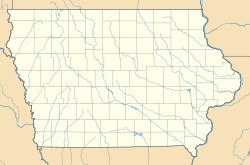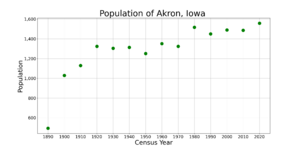Akron, Iowa facts for kids
Quick facts for kids
Akron
|
|
|---|---|
| Motto(s):
"The peaceful valley of opportunity"
|
|

Location of Akron, Iowa
|
|
| Country | |
| State | |
| County | Plymouth |
| Government | |
| • Type | Mayor-council |
| Area | |
| • Total | 1.23 sq mi (3.19 km2) |
| • Land | 1.23 sq mi (3.19 km2) |
| • Water | 0.00 sq mi (0.00 km2) |
| Elevation | 1,142 ft (348 m) |
| Population
(2020)
|
|
| • Total | 1,558 |
| • Density | 1,264.61/sq mi (488.20/km2) |
| Time zone | UTC-6 (Central (CST)) |
| • Summer (DST) | UTC-5 (CDT) |
| ZIP code |
51001
|
| Area code(s) | 712 |
| FIPS code | 19-00775 |
| GNIS feature ID | 0454109 |
Akron is a city located in Plymouth County, Iowa, in the United States. In 2020, about 1,558 people lived there. It's a small but interesting place with a unique history and natural beauty.
Contents
A Look Back: Akron's Story
Akron officially became a city on September 7, 1882. Its name came from a city called Akron, Ohio. It's like the founders liked the name so much, they decided to use it again for their new town!
Where is Akron?
Akron covers an area of about 1.22 square miles (3.19 square kilometers), and it's all land. There are no large lakes or rivers within the city limits.
Akron is known as the "northern gateway" to the Loess Hills. These are very special hills made of windblown soil. They stretch south from Akron all the way to St. Joseph, Missouri. The Loess Hills are a unique natural feature, and you can even drive along the Loess Hills Scenic Byway to see them up close.
Who Lives in Akron?
The number of people living in Akron has changed over the years. Here's a quick look at how the population has grown and shrunk:
| Historical populations | ||
|---|---|---|
| Year | Pop. | ±% |
| 1890 | 494 | — |
| 1900 | 1,029 | +108.3% |
| 1910 | 1,130 | +9.8% |
| 1920 | 1,324 | +17.2% |
| 1930 | 1,304 | −1.5% |
| 1940 | 1,314 | +0.8% |
| 1950 | 1,251 | −4.8% |
| 1960 | 1,351 | +8.0% |
| 1970 | 1,324 | −2.0% |
| 1980 | 1,517 | +14.6% |
| 1990 | 1,450 | −4.4% |
| 2000 | 1,489 | +2.7% |
| 2010 | 1,486 | −0.2% |
| 2020 | 1,558 | +4.8% |
| Source: and Iowa Data Center Source: |
||
Akron's Population Today
In 2020, the city of Akron had 1,558 people. There were 661 households, which are groups of people living together. The city had about 1,264 people per square mile.
Most people in Akron are White (93.3%). A small number of people are from other racial backgrounds. About 4.1% of the population identified as Hispanic or Latino.
The average age in Akron was about 38.9 years old. This means half the people were younger than 38.9, and half were older. About 30% of the residents were under 20 years old.
Learning in Akron
Students in Akron attend schools operated by the Akron–Westfield Community School District. This district includes Akron–Westfield Senior High School. The school district was formed in 1981 when the Akron and Westfield school districts joined together.
Famous Faces from Akron
Even though Akron is a small city, some notable people have connections to it:
- Alan J. Heeger: He won the Nobel Prize in Chemistry in 2002! Alan grew up in Akron, where his dad owned a general store.
- J. Henry Lucken: He was a representative in the Iowa General Assembly from 1947 to 1949. He was born right in Akron.
- Frank J. Swanson: He also served in the Iowa General Assembly from 1929 to 1931. Frank moved to Akron and owned a furniture and hardware business there.
- Anna Johnson Pell Wheeler: A very smart mathematician. She moved to Akron when she was nine years old.
See Also
 In Spanish: Akron (Iowa) para niños
In Spanish: Akron (Iowa) para niños






